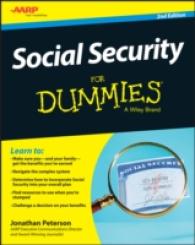- ホーム
- > 洋書
- > 英文書
- > History / World
Full Description
Living Well Together investigates the development of the Neolithic in southeast and central Europe from 6500-3500 cal BC with special reference to the manifestations of settling down. A collection of reports and comments on recent fieldwork in the region, Living Well Together? provides 14 tightly written and targeted papers presenting interpretive discussions from important excavations and reassessments of our understanding of the Neolithic. Each paper makes a significant contribution to existing knowledge about the period, and the book, like its companion (Un)settling the Neolithic (Oxbow 2005) will be a benchmark text for work in this region. The reports in Living Well Together? play out the critical questions posed in the earlier volume: how should one interpret settlement; what of the difference between tells and flat sites; what do we mean by permanent occupation; can we avoid the assumptions that underlie claims for year-round residence or seasonal occupation; why, in some regions and at some times, did people maintain residence for so many generations that monumental tell settlements grew to dominate the visual and social landscape; what would a viewshed analysis of tells reveal; what are the dynamics of households in Neolithic Greece; how should we see the emergence of pottery in terms of material culture; and what were the origins of the LBK, and how can we understand its development? The volume's authors have succeeded in attacking existing thought, in provoking new discussion and in creating new paths to understanding the nature of human existence in the Neolithic. Together they set a new agenda for studying the Neolithic across and beyond southeastern and central Europe.
Contents
Introduction (Douglass Bailey and Alasdair Whittle)
Ilipinar and Mentese: early settlement in the eastern Marmara region (Jacob Roodenberg and Songül Alpaslan-Roodenberg)
Household dynamics and variability in the Neolithic of Greece: the case for a bottom-up approach (Stella Souvatzi)
Tell settlements: a pattern of landscape occupation in the Lower Danube (Radian-Romus Andreescu and Pavel Mirea)
Late Neolithic spatial differentiation at Polgár-Csoszhalom, eastern Hungary (Pál Raczky and Alexandra Anders)
Uivar: a late Neolithic-early Eneolithic fortified tell site in western Romania (Wolfram Schier)
Meet the ancestors: settlement histories in the Neolithic (John Chapman)
The view from the village: the context of tell mapping and habitual visibility (Steven Trick)
Early Neolithic pottery production in Romania: Gura Baciului and Seusa La-Cararea Morii (Transylvania) (Michela Spataro)
Material culture traditions and identity (Elisabetta Starnini)
Sedentary pastoral gatherers in the early Neolithic: architectural, botanical, and zoological evidence for mobile economies from Foeni-Salas, Southwest Romania (Haskel J Greenfield and Tina Jongsma)
Crop husbandry and its social significance in the Körös and LBK periods (Amy Bogaard, Joanna Bending and Glynis Jones)
Inter-generational transmissions of culture and LBK origins: some indications from eastern central Europe (Alena Lukes and Marek Zvelebil)
The boundary in Western Transdanubia: variations of migration and adaptation (Eszter Bánffy)
Perspectives on the beginnings of the earliest LBK in east-central Europe (Eva Lenneis)






